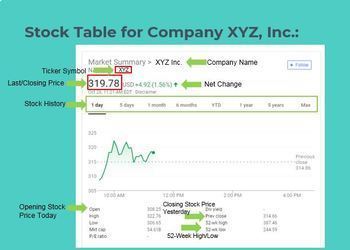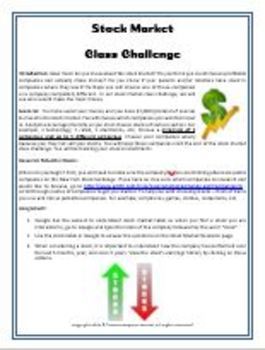Stock Market Game - Stock Market Class Challenge Google Sheets Microsoft Excel
- Zip
- Google Apps™
- Excel Spreadsheets

Description
Perfect for any class to teach students about the Stock Market. There are so many stock market activities out there. I have used this Stock Market Class Challenge to teach 8th graders about the stock market for over 10 years. It is straight forward and easy to follow for students since students are only allowed to invest $1,000. Students can relate much more to $1,000 rather than tens or hundreds of thousands some stock market games use. Students are not allowed to sell their stocks until the end of the activity so they really see the ups and downs of their particular stocks they choose. Students become so involved, you would think they really did invest their own money.
Students will research potential stocks, make a “pretend purchase” and track their stocks for 1 semester (or however long you use chose) either bi-weekly or weekly until “selling” their stocks at the end of the challenge. Students will use Google Sheets or Microsoft Excel and the Internet to complete the activities. Students should be somewhat familiar with how to use Google Sheets or Microsoft Excel. Step-by-step directions are included for each activity.
Stock Market Class Challenge includes 9 Stock Market activities with PowerPoint presentations to introduce most activities, teacher directions, editable Stock Market Progress Sheet, and editable Stock spreadsheets for demonstrations and answers. Each activity is approximately 40 minutes with the exception of the weekly or bi-weekly Stock Market Progress.
Stock Market Game Class Challenges Activities:
- Activity 1 Stock Market Basics – Presentation to Introduce the Stock Market
- Activity 2 Stock Market – Research – Students research potential stocks to invest their $1,000
- Activity 3 Stock Market – Buying Stocks – Presentation to show students how to create a spreadsheet of their stock purchase.
- Activity 4 Stock Market Progress Spreadsheet – Presentation to show students how to track their earnings or losses.
- Activity 5 Stock Progress Updates – Presentation and Editable Stock Market handout.
- Activity 6 MLA Report – Students report on their stock progress, why they chose they stocks, etc.
- Activity 7 Selling Stocks – Presentation and students sell their stocks at the end of the challenge and determine who would have “profited” the most if their investments were real.
- Activity 8 Stock Market Terms Crossword Puzzle – Students will use the Internet to complete the Stock Market Terms Crossword Puzzle.
- Activity 9 Stock Market Ups & Downs – Students research the reasons why the stock market has ups and downs.





